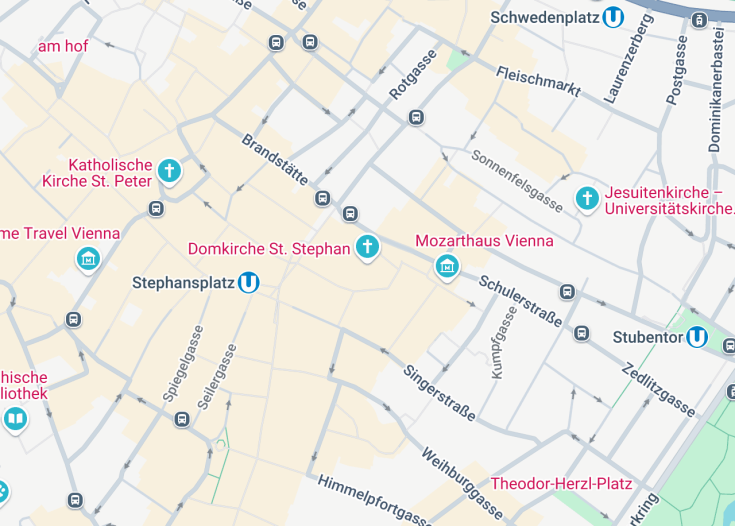Located at the heart of Vienna, St. Stephen’s Cathedral (Stephansdom) stands as a magnificent symbol of Austrian heritage. With its towering spire, intricate tile patterns on the roof, and Gothic architecture, it is not just a religious site but also a cultural icon. Constructed in 1147, this cathedral showcases artistic marvels such as the Altarpiece of Wiener Neustadt, the pulpit by Anton Pilgram, and the tomb of Emperor Frederick III. Its architectural brilliance and historical significance make it a pivotal destination for visitors worldwide.
When visiting St. Stephen’s Cathedral, be sure to climb the South Tower for a breathtaking panoramic view of Vienna’s cityscape.
Consider joining a guided tour to fully appreciate the historical and architectural nuances of St. Stephen’s Cathedral.
St. Stephen’s Cathedral: A Symbol of Gothic Splendor
Located in the heart of Vienna, St. Stephen’s Cathedral stands as a magnificent example of Gothic architecture and a beacon of Austrian heritage. With its towering spire that dominates Vienna’s skyline and its colorful tiled roof, the cathedral attracts visitors from around the world. Beyond its architectural beauty, St. Stephen’s Cathedral is steeped in history; it has witnessed numerous historical events and has been a spiritual center since its construction commenced in the 12th century. Visitors are captivated by its intricate stone carvings, the resonant peal of its bells, and the stunning stained glass windows that illustrate biblical stories. The cathedral is not only a place of worship but also a cultural treasure, hosting concerts and exhibitions that enrich the visitor experience. Its role in Viennese social and cultural life makes it a must-visit for anyone wanting to fully understand the city’s history and its ongoing story.
Exploring the Rich Interiors
Inside St. Stephen’s Cathedral, the awe-inspiring interiors are a highlight for visitors. The main altar and the pulpit are masterpieces of Gothic craftsmanship. Guided tours offer insights into the cathedral’s construction and its relevance in religious and secular history. Notably, the Catacombs tour provides a rare glimpse into Vienna’s past, with a visit to the tombs of important historical figures. Additionally, climbing the South Tower rewards visitors with a breathtaking view of Vienna, while the North Tower houses an exhibition on the cathedral’s famed Pummerin bell.
The Majestic South Tower
One of the most compelling features of St. Stephen’s Cathedral is its South Tower, known locally as ‘Steffl’. Towering at 136 meters, it offers some of the most spectacular aerial views of Vienna. Ascending the tower’s 343 steps is a popular activity, allowing visitors to appreciate both the architectural details up close and the expansive urban landscape of Vienna. This ascent is particularly recommended for photography enthusiasts and anyone looking for a unique way to experience the city from above.
Discover the beauty of st. stephen’s cathedral
St. Stephen’s Cathedral in Vienna, a masterpiece of architectural art, is not only a delight for those interested in history and culture but also captivates families, couples, and older visitors with its breathtaking beauty and profound historical significance. Once inside, visitors can expect an awe-inspirational experience, ranging from its stunning Gothic architecture to its rich historical narratives. The cathedral offers a vivid journey through Vienna’s past and present, making it an ideal destination for anyone seeking a deep cultural immersion into the heart of Austria.
Best time to visit st. stephen’s cathedral
Visiting St. Stephen’s Cathedral can be a remarkable experience at any time of the year, but spring and autumn offer the most pleasant weather, enhancing your experience as you explore its detailed façades and interiors. During these seasons, the milder temperatures make it comfortable to spend hours admiring the artwork and climbing the tower for a panoramic view of Vienna.
Annual musical highlights
The cathedral hosts an array of classical music concerts featuring renowned orchestras and choirs that fill the nave with enchanting sounds, particularly enchanting during the Christmas period and Easter week.
Accessibility and limitations at st. stephen’s cathedral
St. Stephen’s Cathedral is dedicated to making its premises accessible to all, yet there are some important limitations to note.
Accessibility
The cathedral is equipped with ramps and elevators to assist those with mobility challenges. The main areas and the treasury are accessible by wheelchair.
Limitations
- Photography restrictions: No photography during mass or church services.
- Dress code enforced: Appropriate attire required, shoulders and knees must be covered.
- Age restriction for tower climbs: Children under 14 must be accompanied by an adult.
Notes to visitors
- Prepare for considerable physical effort if climbing the tower’s stairs.
- Language barrier: Most tours and informational placards are available in English and German.
- Requested behaviour: Maintain a respectful silence inside the sanctuary.
General informations
Details for your visit to St. Stephen’s Cathedral
Location
The cathedral is centrally located, close to major landmarks such as the Hofburg Palace and the State Opera. The Stephansplatz metro station is just steps away, making it easily accessible by public transport.
Address: Stephansplatz 3, 1010 Wien, Austria.
Opening hours
Monday to Saturday from 09:00 AM to 11:30 AM and 1:00 PM to 4:30 PM. Sundays and public holidays from 1:00 PM to 4:30 PM. The cathedral is closed during mass services.
How to reach st. stephen’s cathedral
Car
Vienna is well-connected by roads. Parking might be available at nearby locations.
| Route | Distance | Travel time |
|---|---|---|
| From Vienna Airport | 20 km | 25 minutes |
| From Salzburg | 300 km | 3 hours |
| From Budapest | 250 km | 2.5 hours |
Public Transport
Catching a metro or a bus to Stephansplatz station is advised. It’s a hub for many lines making it easily accessible from various parts of the city.
nearby attractions
- Hofburg Palace – 800 meters (0.5 miles)
- Vienna State Opera – 1 km (0.6 miles)
- The Museum of Natural History – 1.5 km (0.93 miles)
- The Albertina – 900 meters (0.56 miles)
- The Belvedere Palace – 3 km (1.86 miles)
- The Prater – 3 km (1.86 miles)
- Vienna City Hall – 2 km (1.24 miles)
- Austrian National Library – 1 km (0.62 miles)
- Kunsthistorisches Museum – 1.5 km (0.93 miles)
- Schönbrunn Palace – 8 km (4.97 miles)
- Donauinsel – 4.5 km (2.8 miles)
- Karlskirche – 2 km (1.24 miles)
What is the architectural style of St. Stephen's Cathedral in Austria?
What are the main features of St. Stephen's Cathedral?
- The South Tower: Known as ‘Steffl’, it is the cathedral’s highest point at 136 meters and offers a panoramic view of Vienna.
- The North Tower: It houses the Pummerin, the second largest free-swinging church bell in Europe.
- The Roof: Notable for its colorful tile mosaic forming the Royal and Imperial double-headed eagle and the coat of arms of the city of Vienna.
- The Cathedral’s Interior: Features numerous altars and chapels, including the High Altar, which was built over seven years from 1641 to 1647.
- The Catacombs: These underground chambers house the remains of over 10,000 people, including members of the Habsburg royal family.
The rich detailing and historical significance of each element make St. Stephen’s a fascinating exploration for visitors.
What historical events took place at St. Stephen's Cathedral?
- Royal Weddings and Funerals: The cathedral has been a frequent venue for royal events, including weddings of the Habsburg family and other nobility.
- Viennese Resistance: During World War II, the cathedral was damaged by both fire and allied bombings. However, it was quickly restored as a symbol of Austrian resilience and identity.
- Major Renovations: In the 14th century and again in the 19th century, St. Stephen’s underwent major renovation efforts that transformed both its architecture and internal furnishings, adding to the blend of styles seen today.
- Cultural Gatherings: The cathedral also serves as a focal point for many cultural and religious gatherings in Austria.
These events not only reflect the historical significance of the cathedral but also its central role in the cultural and social life of Vienna.
Are there any unique artworks inside St. Stephen's Cathedral?
- Altars: The High Altar, created by Tobias Pock in 1647, is an exquisite example of baroque art.
- Pulpits: The stone pulpit, made by Anton Pilgram in the early 16th century, is renowned for its intricate carvings, including the self-portrait of Pilgram peering out of a window.
- Statues and Relics: The cathedral also contains numerous statues, including one of St. Christopher on the south tower, as well as significant relics like the tooth of St. Stephen, the cathedral’s namesake.
- Paintings: There are also several valuable paintings from various periods of European art history, including works from the Renaissance and Baroque periods.
- Stained Glass Windows: A collection of colorful stained glass windows adds to the cathedral’s aesthetic and historical value, some of which date back to the 14th century.
These artworks are integral to the cathedral’s identity and contribute to its status as a major cultural and historical site.
How did St. Stephen's Cathedral get its name?
Can visitors access the towers of St. Stephen's Cathedral?
What kind of restorations has St. Stephen's Cathedral undergone?
Does St. Stephen's Cathedral hold any significant relics?
What are the unique features of the roof of St. Stephen's Cathedral?
What type of music events are held at St. Stephen's Cathedral?
- Organ Concerts: The cathedral’s massive organ, one of the largest in Austria, is used for regular concerts featuring works from famous composers such as Bach and Mozart.
- Choir Performances: The cathedral also serves as a venue for performances by its own choir and visiting choirs from around the world.
- Classical Music Concerts: These concerts often include performances of sacred music as well as classical pieces suited to the grandeur and solemnity of the cathedral setting.
These events attract not only locals but also international visitors who are eager to experience the rich musical heritage of Vienna.
Is there a guided tour available for St. Stephen's Cathedral?
What is the significance of the Pummerin bell in St. Stephen's Cathedral?

Is St. Stephen’s Cathedral in Vienna worth visiting?
St. Stephen’s Cathedral, a prominent landmark in Vienna, stands out for its gothic architecture and historical significance. The cathedral’s towering presence and intricate stone work make it a photogenic spot, ideal for those interested in history and architecture. Inside, the artistic details and stained glass add to its allure, offering a glimpse into the past craftsmanship.
However, while it is a must-see for history and architecture enthusiasts, some visitors might find it less appealing if they are not fans of religious or historical sites. For those looking for modern entertainment or shopping, the nearby areas might offer more engaging options. Nonetheless, St. Stephen’s Cathedral remains a cultural staple in Vienna’s tourist scene, worthy of a visit if one appreciates the intertwining of art, history, and spirituality.









